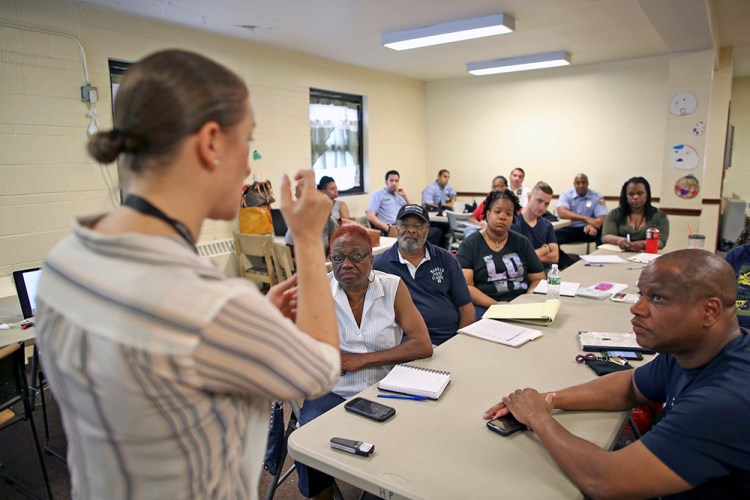PHILADELPHIA — In all of last year, there were only 22 days when someone wasn’t shot in Philadelphia. Nearly 1 in 5 victims died.
Now, in a bold effort to stem the bloodshed, several Philadelphia hospitals are about to conduct a citywide experiment that will ask: When gunshot or stabbing victims are being rushed to the emergency room by ambulance, could paramedics do more to save them by doing less?
It’s a counterintuitive approach that could test long-held beliefs and change practices at trauma centers across the country.
And every resident of or visitor to Philadelphia could become a study subject, though the biggest effect will probably be in the most violent neighborhoods — poor, mostly black sections where people are skeptical of essentially being experimented on.
During the study, paramedics treating adults who have been shot or stabbed in the torso will, on a random basis, not insert a tube down a victim’s throat or administer intravenous fluids – two traditional life-saving techniques some doctors say may actually harm such patients.
WRISTBAND WITH A MESSAGE
Normally, paramedics intubate patients to keep their airway open, and give IV fluids to counteract a drop in blood pressure. But supporters of the study say that for victims who are bleeding through an open wound, these procedures may cause an increase in blood pressure that can accelerate blood loss and death.
Philadelphians who don’t want to participate in the study if they are ever wounded can opt out by wearing wristbands indicating their wishes. They can obtain a wristband by filling out a form online or on paper.
The study is expected to start in the fall and last five years, or until doctors have about 1,000 patients, whichever comes first. It could end early if researchers are able to prove or disprove their theory sooner.
It is being headed by Temple University Hospital’s chief of surgery, Dr. Amy Goldberg, who has treated thousands of shooting victims in the three decades she has worked in Philadelphia.
“If this is not a public health crisis, I don’t know what is,” she said.
Last year, there were 236 homicides in Philadelphia and more than 1,200 shootings, or one roughly every seven hours. Of those victims, nearly 700 were black men ages 18 to 34.
Temple has been working for five years to set up the study. As part of the process, Dr. Zoe Maher, a Temple trauma surgeon, has been giving presentations at community forums.
Maher, who is white, gave a 20-minute slideshow at a recent meeting in Hunting Park, a largely black and Hispanic neighborhood. Her audience was initially dubious.
“You’re using people to do this study,” said Charles Lanier, head of a neighborhood revitalization group. “I hear what you’re saying, but in the interim, you’re still sacrificing somebody to prove which (method) is better.”
Yanitza Gonzalez, a councilwoman’s representative, chimed in: “It’s almost like we’re gambling with people’s lives.”
Joann Taylor, a block captain, retorted: “We’re already gambling with people’s lives.”
The Temple surgeon patiently laid out her case, even as she acknowledged the selection process is “like the flip of a coin.” Retrospective studies, she said, have shown that gunshot and stabbing victims given basic life support – such as an oxygen mask, CPR or immobilization – had an 18 percentage-point survival advantage over those given advanced procedures, such as intubation, in an ambulance.
The study, involving all six of Philadelphia’s trauma hospitals, has been exempted from the Food and Drug Administration’s informed-consent rules, which require research subjects to be told the risks and benefits and to give permission in advance — something not feasible with gravely wounded people.
Organizers had to meet certain requirements before launching the study, including getting approval from city and hospital review boards that oversee research on humans, holding community meetings and informing a certain percentage of the public.
Karen Maschke, a scholar at the Hastings Center, a medical ethics think tank in suburban New York City, said the experiment appears ethically sound.
“Getting to the emergency room, where equipment and experts are waiting, is a really critical window, especially for people with any kind of wound that involves bleeding,” said Maschke, editor of the journal IRB: Ethics & Human Research. “Sometimes that’s going to mean you can’t stop and ask people if it’s OK.”
‘SCOOP AND RUN’
A version of this experimental approach is already in place.
For a generation, many Philadelphia police officers, instead of waiting for an ambulance, have been taking shooting and stabbing victims to the ER in their cruisers, a practice known as “scoop-and-run.” Data from the longstanding practice helped inform the surgeons proposing this study.
“All of the evidence we have points to us being right, but if we are wrong, we will end the study early,” Maher told the community group.
Some paramedics have opted out of participating.
Dr. Patrick Reilly, trauma chief at Penn Presbyterian Hospital, a study partner, said doctors and society tend to think more is better.
“If we said we were going to give another medicine, people would tend to go, ‘Let’s see if this works,’ ” he said. “This might be a situation where more isn’t better.”
Send questions/comments to the editors.


